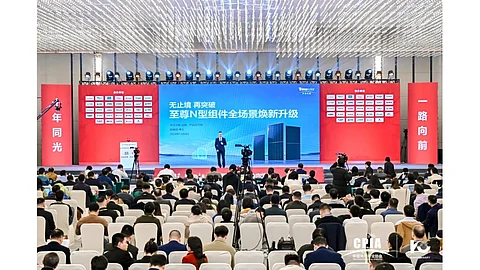

Trinasolar has upgraded its Vertex n-type solar modules with next-generation i-TOPCon Ultra technology
The 3 modules introduced under TOPCon 2.0 have 495 W, 670 W and up to 760 W power rating
It aims to start with a 10 GW initial annual capacity in production with delivery starting in Q2 2025
Vertically integrated solar PV manufacturer Trinasolar has unveiled its upgraded full-scenario Vertex n-type solar module series, based on its next-generation i-TOPCon Ultra technology that it categorizes under the TOPCon 2.0 era. The largest module in this series, targeting the utility-scale segment, has a power output of up to 760 W.
Introduced by the manufacturer at the 2024 China Photovoltaic Industry Association (CPIA) Annual Conference, the module is available in large, medium, and small versions. The medium format module, for the commercial and industrial (C&I) segment and mountainous terrains, has up to 670 W rating, while the smaller one reaches up to 495 W.
Module efficiency is claimed as 24.5% for the large format, 24.8% for the medium, and 24.8% for the small.
The small format modules will cater to residential rooftops in Europe and North America, and villas in China.
Speaking at the conference, Trinasolar’s Head of Strategy, Product and Market, Dr. Yingbin Zhang, shared that the upgraded Vertex n-type module offers significant advantages in all scenarios, especially distributed generation.
Compared to TOPCon 1.0, under TOPCon 2.0, the bifaciality has further increased by 5% to 90% to ensure the back of the module generated additional value for the customer. Their temperature coefficient is also reduced by 0.01%.
Zhang claimed that the new modules have anti-UV attenuation capabilities, with an attenuation rate of no more than 1% in the first year and 0.4% year by year.
Trinasolar sees potential for further improvement as it recently announced 26.58% TOPCon solar cell efficiency that increased within a month from 25.9% it reported in October this year (see Trinasolar Achieves 26.58% ‘Record’ N-Type TOPCon Solar Cell Efficiency).
For the modules, it believes the use of double-sided fully passivated contact technology, light trap technology, ultra-fine grid line technology, etc. will further expand the annual cell efficiency improvement of 0.3-0.4%, and exceed mass production efficiency of 27%. Module power will also increase by another 15-20 W, he added.
Trinasolar plans to start mass production and delivery of these new modules in Q2 of 2025 with an initial production capacity of 10 GW. The manufacturer added that the capacity will be adjusted based on market demand.
Trinasolar’s Product Manager Lukas Ye will share the company’s i-TOPCon high efficiency solar cell technology roadmap on December 10, 2024 at TaiyangNews High Efficiency Solar Technologies Conference. Register free here to attend the event.
